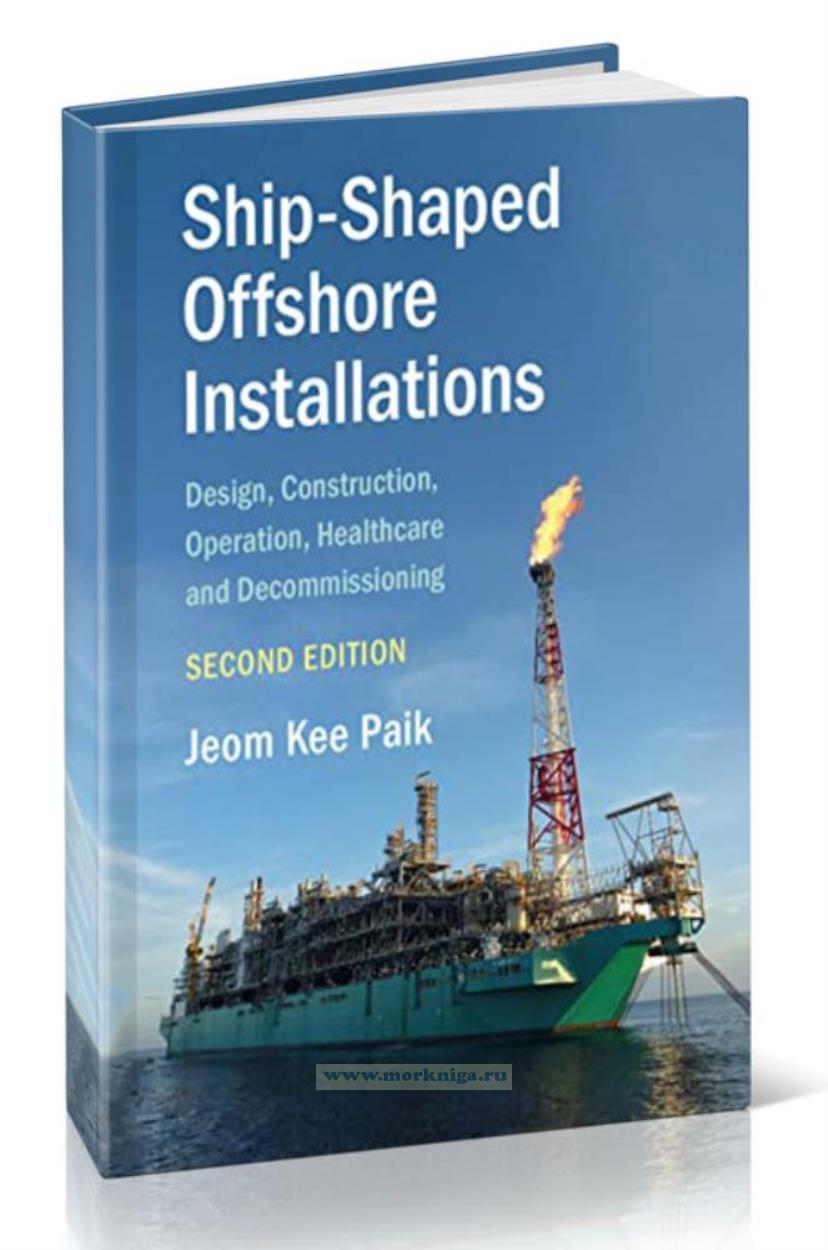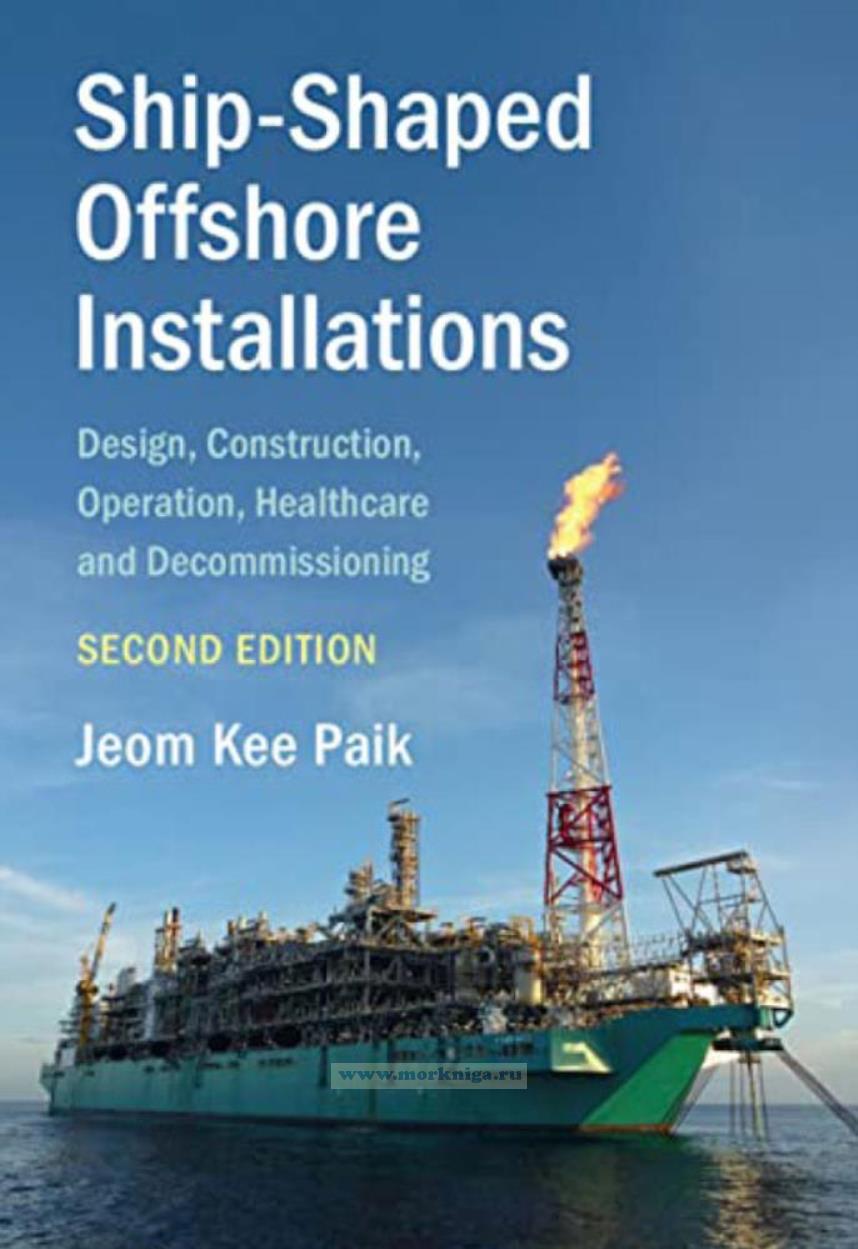Ship-Shaped Offshore Installations: Design, Construction, Operation, Healthcare and Decommissioning/Корабельные установки: проектирование, строительство, эксплуатация, безопасность и вывод из эксплуатации
Книга на английском языке
Advances in human civilisation have led the development of various types of engineered structures. The ship-shaped offshore installation is a type of engineered structure that uses the space and resources of the ocean to develop energy. Ship-shaped offshore installations are exemplified by floating storage and offloading (FSO) units; floating production, storage and offloading (FPSO) units (for the development of offshore oil or gas); floating power plants (fuelled by liquefied natural gas or nuclear reactors) and floating storage and regasification units (FSRUs).
Contents
Preface to the Second Edition page
Preface to the First Edition
1 Introduction to Ship-Shaped Offshore Installations
1.1 Types of Ship-Shaped Offshore Installations
1.2 Trading Tankers versus Ship-Shaped Offshore Installations
1.3 New Builds versus Tanker Conversions
1.4 Tanker Conversions
1.5 Front-End Engineering and Design for New Builds
1.6 Characteristics of As-Built Ship-Shaped Offshore Installations
1.7 Hypothetical Designs of Ship-Shaped Offshore Installations
References
2 Structural Steel Selection and Construction
2.1 Steel Selection for Hull Structures
2.2 Chemical and Mechanical Properties of Structural Steels
2.3 Relationship between Stress and Strain of Materials
2.4 Elastic-Perfectly Plastic Material Model
2.5 Effect of Elevated Temperatures
2.6 Effect of Sub-zero Temperatures and Cryogenic Conditions
2.7 Effect of Impact Loading
2.8 Effect of Corrosion
2.9 Welding Procedures and Techniques
2.10 Welding-Induced Initial Imperfections
2.11 Prevention of Welding-Induced Deformations
2.12 Construction of Topside Modules
2.13 Interface between the Hull and Topside Module
References
3 Ocean Environmental Conditions
3.1 Types of Ocean Environmental Conditions
3.2 Return Period of Ocean Environmental Conditions
3.3 Wind
3.4 Waves
3.5 Current
3.6 Non-collinear Combination of Waves, Wind, Current and Swell
3.7 Tide
3.8 Sea Surface Temperature
3.9 Snow and Icing
3.10 Marine Growth
3.11 Seafloor Earthquakes and Tsunami
3.12 Tank Sloshing
3.13 Slamming
3.14 Green Water
References
4 Site-Specific Wave-Induced Hull Girder Loads
4.1 Principles of Hull Girder Load Prediction
4.2 Parameters That Affect Hull Girder Loads
4.3 Site-Specific Wave Data at Nautical Zones
4.4 Site-Specific Wave Database of Six Seas
4.5 Probability Density Functions of the Wave Parameters in Six Seas
4.6 Probabilistic Selection of Benign Wave Scenarios in Six Seas
4.7 Analysis of Motions and Wave-Induced Hull Girder Loads
4.8 Probability of Exceedance Diagrams
4.9 Survival Conditions
4.10 Tow Conditions
References
5 Serviceability Limit States
5.1 Principles of Serviceability Limit States Engineering
5.2 Structural Idealisations
5.3 Elastic Deflection Limits under Quasi-static Actions
5.4 Elastic Plate Buckling Limits
5.5 Elastic Flange Buckling Limits
5.6 Permanently Set Plate-Deflection Limits under Impact Pressure Actions
5.7 Stability of Ship-Shaped Offshore Installations
5.8 Weathervaning and Heading Control of Ship-Shaped Offshore Installations
5.9 Excessive Motion of Ship-Shaped Offshore Installations
5.10 Vibration and Noise
5.11 Vortex-Induced Vibrations
References
6 Fatigue Limit States
6.1 Principles of Fatigue Limit States Engineering
6.2 Approaches for Fatigue Limit States Engineering
6.3 Types of Critical Structural Details
6.4 Safety Factors for Fatigue Limit States
6.5 Types of Stresses at Structural Details
6.6 Cyclic Stress Ranges
6.7 S-N Curves
6.8 Criteria for Fatigue Limit States
6.9 High Cycle Fatigue versus Low Cycle Fatigue
6.10 Fatigue Limit States Assessment of Ship-Shaped Offshore Installations
6.11 Crack Growth Models
References
7 Ultimate Limit States
7.1 Principles of Ultimate Limit States Engineering
7.2 Ultimate Strength of Plates
7.3 Ultimate Strength of Stiffened Panels
7.4 Ultimate Strength of Hull Girders
7.5 Structural Collapse Triggered by Fracture
7.6 Structural Collapse in Fires
7.7 Ultimate Strength under Cyclic Loading
7.8 Ultimate Strength of Aged Structures
7.9 Dynamic Ultimate Strength of Plates under Impact Axial Compressive Loads
References
8 Accidental Limit States
8.1 Principles of Accidental Limit States Engineering
8.2 Accidental Flooding
8.3 Collisions with Ships
8.4 Collisions with Icebergs
8.5 Dropped-Object Impacts
8.6 Fires
8.7 Explosions
References
9 Mooring System Engineering
9.1 Principles of Mooring System Engineering
9.2 Types of Mooring Systems
9.3 Selection of the Mooring System
9.4 Safety Engineering of Disconnectable Mooring Systems
References
10 Sloshing Impact Engineering
10.1 Principles of Sloshing Impact Engineering
10.2 Procedure for Sloshing Load Analysis
10.3 Probabilistic Selection of Sloshing Scenarios
10.4 Computational Fluid Dynamics Simulations for Wind and Current Forces
10.5 Computational Fluid Dynamics Simulations for Hull Motions in Waves, Wind and Current
10.6 Decomposition of the Hull Motion Components of a Ship-Shaped Offshore Installation
10.7 Computational Fluid Dynamics Simulations for Tank Sloshing
10.8 Determination of Design Sloshing Pressure Loads
10.9 Procedure for Sloshing Response Analysis
References
11 Seismic Impact Engineering
11.1 Principles of Seismic Impact Engineering
11.2 Computational Modelling for Seismic Response Analysis
11.3 Procedure for Nonlinear Seismic Response Analysis
11.4 Modelling of Site-Specific Seismic Load Profiles
11.5 Finite-Element Modelling
11.6 Seismic Responses of a Ship-Shaped Nuclear Power Plant Hull
References
12 Aircraft Impact Engineering
12.1 Principles of Aircraft Impact Engineering
12.2 Procedures for Aircraft Impact Engineering
12.3 Modelling of the Striking Body
12.4 Modelling of Ballasting Materials
12.5 Modelling of the Struck Body
12.6 Analysis of Computational Results
References
13 Quantitative Risk Assessment and Management
13.1 Principles of Risk-Based Safety Engineering
13.2 Probabilistic Selection of Event Scenarios
13.3 Analyses of Frequency and Consequences
13.4 Probability of Exceedance Diagrams
13.5 Fire Risk on Topsides
13.6 Fire Risk on Helicopter Decks
13.7 Explosion Risk on Topsides
13.8 Collision Risk with Vessels
References
14 Life-Cycle Corrosion Assessment and Management
14.1 Principles of Life-Cycle Corrosion Engineering
14.2 Phenomenological Actions Causing Corrosion
14.3 Types of Corrosion in Ship-Shaped Offshore Installations
14.4 Operational Factors Affecting Corrosion
14.5 Life-Cycle Behaviour of Corrosion
14.6 Prediction of Life-Cycle Corrosion Behaviour
14.7 Residual Strength of Corroded Structures
14.8 Options for Life-Cycle Corrosion Management
References
15 Lifetime Healthcare and Safe Decommissioning
15.1 Principles of Lifetime Healthcare
15.2 Types of In-Service Damage
15.3 Methods for Damage Detection
15.4 Health Condition Monitoring
15.5 Health Condition Assessment
15.6 Remedial Actions
15.7 Likely Future Health Condition Assessment and Management: Case Study
15.8 Regulatory Framework for Safe Decommissioning
15.9 Challenges for Safe Decommissioning
15.10 Decommissioning Practices
15.11 Decommissioning Cost Estimation
15.12 Digital Twins for Lifetime Healthcare
References
Appendix 1 Glossary of Maritime Engineering Terms
Appendix 2 Scale Definitions of Wind, Waves and Swells
Appendix 3 Sea State Data in Various Ocean Regions
Appendix 4 Inverse First-Order Reliability Method for Drawing Extreme Wave Contours
Appendix 5 Source Listing of the FORTRAN Computer Program USAS-L
Appendix 6 Source Listing of the FORTRAN Computer Program USAS-S
Index

